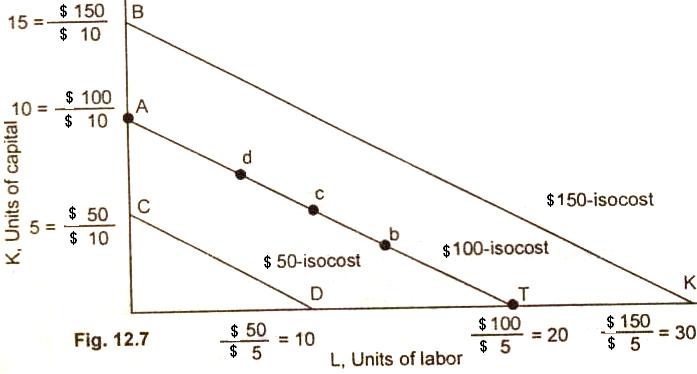Isocost Lines/Outlay
Line/Price Line/Factor Cost Line:
Definition:
A firm can produce a given level of
output using efficiently different combinations of two inputs.
For choosing efficient combination of the inputs, the producer
selects that combination of factors which has the lower cost of
production. The information about the cost can be obtained from
the isocost lines.
Explanation:
An isocost line is also
called outlay line or price line or factor cost line. An
isocost line shows all the combinations of labor and capital
that are available for a given total cost to-the producer. Just
as there are infinite number of
isoquants, there are infinite number of isocost lines, one
for every possible level of a given total cost. The greater the
total cost, the further from origin is the isocost line.
Example:
The isocost line can be explained
easily by taking a simple example.
Diagram/Figure:

Let us examine a firm which wishes
to spend $100 on a combination of two factors labor and capital
for producing a given level of output. We suppose further that
the price of one unit of labor is $5 per day. This means that
the firm can hire 20 units of labor. On the other hand if the
price of capital is $10 per unit, the firm will purchase 10
units of capital. In the fig. 12.7, the point A shows 10 units
of capital used whereas point T shows 20 units of labor are
hired at the given price. If we join points A and T, we get a
line AT. This AT line is called isocost line or outlay line. The
isocost line is obtained with an outlay of $100.
Let us assume now that there is no
change in the market prices of the two factors labor and capita!
but the firm increases the total outlay to $150. The new price
line BK shows that with an outlay of $150, the producer can
purchase 15 units of capital or 30 units of labor. The new price
line BK Shifts upward to the right. In case the firm reduces the
outlay to $50 only, the isocost line CD shifts downward to the
left of original isocost line and remains parallel to the
original price line.
The isocost line plays a similar
role in the firm's decision making as the budget line does in
consumer's decision making. The only difference between the two
is that the consumer has a single budget line which is
determined by the income of the consumer. Whereas the firm faces
many isocost lines depending upon the different level of
expenditure the firm might make. A firm may incur low cost by
producing relatively lesser output or it may incur relatively
high cost by producing a relatively large quantity.
Relevant Articles:
|